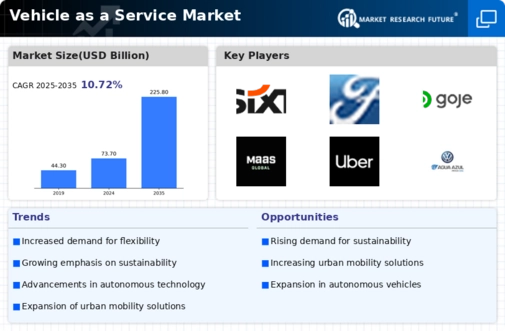The Vehicle as a Service Market (VaaS) market is currently characterized by a dynamic competitive landscape, driven by technological advancements and shifting consumer preferences towards mobility solutions. Key players such as Uber Technologies Inc (US), Daimler AG (DE), and Rivian Automotive Inc (US) are actively shaping the market through innovative strategies and operational focuses. Uber Technologies Inc (US) continues to enhance its ride-hailing services by integrating electric vehicles into its fleet, aiming to reduce carbon emissions and appeal to environmentally conscious consumers. Meanwhile, Daimler AG (DE) is leveraging its expertise in automotive manufacturing to expand its mobility services, focusing on partnerships with local governments to create integrated transport solutions. Rivian Automotive Inc (US), on the other hand, is positioning itself as a leader in electric vehicle technology, emphasizing its commitment to sustainability and adventure-oriented mobility solutions, which resonates with a growing segment of eco-conscious consumers.
The business tactics employed by these companies reflect a broader trend towards localization and supply chain optimization. The VaaS market appears moderately fragmented, with numerous players vying for market share, yet the influence of major companies is substantial. Their collective strategies, including regional expansions and technological innovations, contribute to a competitive environment that encourages continuous improvement and adaptation. This competitive structure fosters an ecosystem where collaboration and strategic partnerships are increasingly vital for success.
In August 2025, Uber Technologies Inc (US) announced a partnership with a leading electric vehicle manufacturer to introduce a fleet of autonomous electric vehicles in select urban areas. This strategic move is significant as it not only enhances Uber's service offerings but also aligns with global sustainability goals, potentially setting a new standard for urban mobility. The integration of autonomous technology is likely to attract a new customer base while reducing operational costs in the long run.
In September 2025, Daimler AG (DE) launched a new initiative aimed at developing smart city solutions in collaboration with various municipalities. This initiative underscores Daimler's commitment to integrating its mobility services with urban infrastructure, thereby enhancing the efficiency of public transport systems. Such strategic actions may position Daimler as a key player in the future of urban mobility, where seamless integration of services is paramount.
In July 2025, Rivian Automotive Inc (US) unveiled its plans to expand its charging network across major metropolitan areas, aiming to support its growing fleet of electric vehicles. This expansion is crucial as it addresses one of the primary barriers to electric vehicle adoption—charging infrastructure. By enhancing accessibility to charging stations, Rivian not only bolsters its market position but also contributes to the broader acceptance of electric vehicles in the VaaS market.
As of October 2025, the competitive trends within the VaaS market are increasingly defined by digitalization, sustainability, and the integration of artificial intelligence. Strategic alliances among key players are shaping the landscape, fostering innovation and enhancing service delivery. The shift from price-based competition to a focus on technological advancement and supply chain reliability is evident, suggesting that future competitive differentiation will hinge on the ability to innovate and adapt to evolving consumer demands.


















Leave a Comment